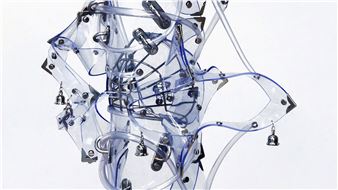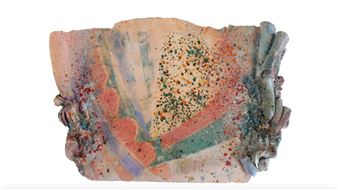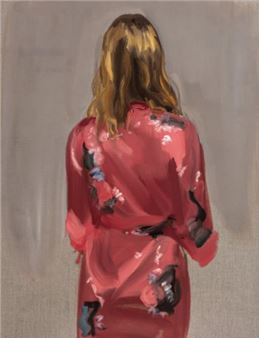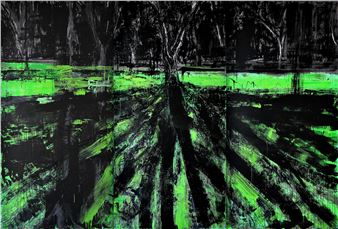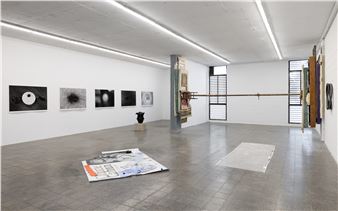Philippe ฐไดวฒตฒิรฉฑ๐ โ A Sea of Sand
In ฐไดวฒตฒิรฉฑ๐โs current show at the Litvak Gallery, mounted in cooperation with the Daniel Templon Gallery in Paris, paintings of urban architecture inspired by the artistโs visit to Tel Aviv last year will be displayed side-by-side with paintings of sandcastles. The two subjects are linked by ฐไดวฒตฒิรฉฑ๐โs fragile technique of painting with wax. This serves as both a description of the sandcastles, which can be destroyed in an instant, and a description of Tel Avivโs impressive architecture as a city that will gradually slip away. In these paintings, as in Jacques Prรฉvertโs poem, A Page of Writing, it seems as if โthe windows become sand again,โ the metal melts and the buildingโs framework turns into misty smoke and dissipates slowly, until it vanishes.
At the beginning of the 1990s, ฐไดวฒตฒิรฉฑ๐ started to use photographed images as the jumping-off point for his paintings. He photographs his immediate environment and the places he visits and later transfers the images to canvas. Over the years, ฐไดวฒตฒิรฉฑ๐ developed a unique painting technique that uses melted wax combined with pigments on canvas. He spreads the wax on the canvas, places sheets of plastic over it and then melts it with an iron. When he finishes, he removes the plastic to reveal sculptural surfaces, rough and scarred, which add another dimension to the two-dimensional painting. ฐไดวฒตฒิรฉฑ๐ creates the effect of an image that is familiar yet distorted, as if frozen in space with a blurring of the distinctions between past and present, fantasy and reality. In his paintings, the buildings of Tel Aviv are characterized by asymmetry, incompleteness and destruction; perhaps this is an expression of the artistโs or the viewersโ feelings in light of the ever-present security threats.
A graduate of the Academy of Fine Arts in Nantes in western France, ฐไดวฒตฒิรฉฑ๐ now divides his des Beaux-arts since 2005. He received the Prix de Rome in 1982, the Prix de Villa Medicis in Rome in 1990 and was a finalist for the Marcel Duchamp Prize in 2004.
During the past few years, his works have been displayed in numerous public institutions in France, including the Musรฉe des Beaux Arts dโAngers (2005); the Fondation Jean-Marc et Claudine Salomon, Chรขteau dโArenthon, Alex (2006); and FRAC Haute-Normandie, Sotteville-lรจs-Rouen (2007). In 2011, the Palace of Versailles opened a permanent exhibition of his work รณฆณ๓ดว, consisting of 44 circular paintings, which was commissioned for the newly renovated Grand Commun building.
Currently ฐไดวฒตฒิรฉฑ๐ is participating in a group exhibition at the new center for contemporary art, Hangar ร bananes, in Nantes. The exhibition was curated by Jean- Charles Vergne and also includes works by Darren Almond, Marc Bauer, Eberhard Havekost and Jim Jarmusch. The Museum of Modern and Contemporary Art in Grenoble, France, will mount a comprehensive exhibition of ฐไดวฒตฒิรฉฑ๐โs work in October, 2012.
ฐไดวฒตฒิรฉฑ๐โs works are highly sought after by international collectors and are shown regularly at prominent art fairs throughout the world, including Art Basel in Switzerland, Art Paris and many more. His works also form part of the permanent collection of major public institutions, such as the Cartier Foundation, the Pompidou Center, the Ludwig Museum in Aachen, Germany, and the National Foundation for Contemporary Art, Paris.
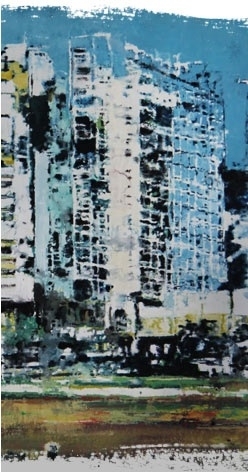
Recommended for you
In ฐไดวฒตฒิรฉฑ๐โs current show at the Litvak Gallery, mounted in cooperation with the Daniel Templon Gallery in Paris, paintings of urban architecture inspired by the artistโs visit to Tel Aviv last year will be displayed side-by-side with paintings of sandcastles. The two subjects are linked by ฐไดวฒตฒิรฉฑ๐โs fragile technique of painting with wax. This serves as both a description of the sandcastles, which can be destroyed in an instant, and a description of Tel Avivโs impressive architecture as a city that will gradually slip away. In these paintings, as in Jacques Prรฉvertโs poem, A Page of Writing, it seems as if โthe windows become sand again,โ the metal melts and the buildingโs framework turns into misty smoke and dissipates slowly, until it vanishes.
At the beginning of the 1990s, ฐไดวฒตฒิรฉฑ๐ started to use photographed images as the jumping-off point for his paintings. He photographs his immediate environment and the places he visits and later transfers the images to canvas. Over the years, ฐไดวฒตฒิรฉฑ๐ developed a unique painting technique that uses melted wax combined with pigments on canvas. He spreads the wax on the canvas, places sheets of plastic over it and then melts it with an iron. When he finishes, he removes the plastic to reveal sculptural surfaces, rough and scarred, which add another dimension to the two-dimensional painting. ฐไดวฒตฒิรฉฑ๐ creates the effect of an image that is familiar yet distorted, as if frozen in space with a blurring of the distinctions between past and present, fantasy and reality. In his paintings, the buildings of Tel Aviv are characterized by asymmetry, incompleteness and destruction; perhaps this is an expression of the artistโs or the viewersโ feelings in light of the ever-present security threats.
A graduate of the Academy of Fine Arts in Nantes in western France, ฐไดวฒตฒิรฉฑ๐ now divides his des Beaux-arts since 2005. He received the Prix de Rome in 1982, the Prix de Villa Medicis in Rome in 1990 and was a finalist for the Marcel Duchamp Prize in 2004.
During the past few years, his works have been displayed in numerous public institutions in France, including the Musรฉe des Beaux Arts dโAngers (2005); the Fondation Jean-Marc et Claudine Salomon, Chรขteau dโArenthon, Alex (2006); and FRAC Haute-Normandie, Sotteville-lรจs-Rouen (2007). In 2011, the Palace of Versailles opened a permanent exhibition of his work รณฆณ๓ดว, consisting of 44 circular paintings, which was commissioned for the newly renovated Grand Commun building.
Currently ฐไดวฒตฒิรฉฑ๐ is participating in a group exhibition at the new center for contemporary art, Hangar ร bananes, in Nantes. The exhibition was curated by Jean- Charles Vergne and also includes works by Darren Almond, Marc Bauer, Eberhard Havekost and Jim Jarmusch. The Museum of Modern and Contemporary Art in Grenoble, France, will mount a comprehensive exhibition of ฐไดวฒตฒิรฉฑ๐โs work in October, 2012.
ฐไดวฒตฒิรฉฑ๐โs works are highly sought after by international collectors and are shown regularly at prominent art fairs throughout the world, including Art Basel in Switzerland, Art Paris and many more. His works also form part of the permanent collection of major public institutions, such as the Cartier Foundation, the Pompidou Center, the Ludwig Museum in Aachen, Germany, and the National Foundation for Contemporary Art, Paris.
Artists on show
Contact details


 ARTISTS
ARTISTS









